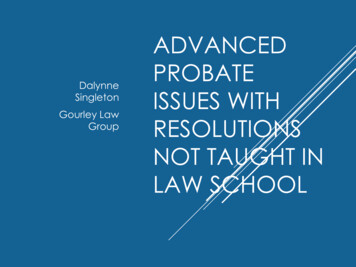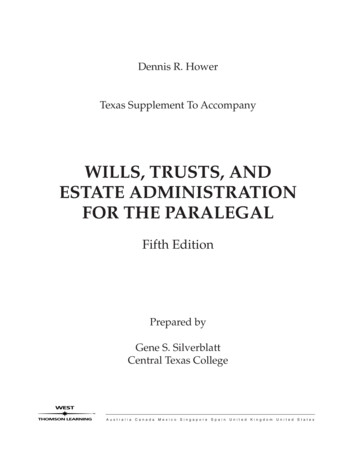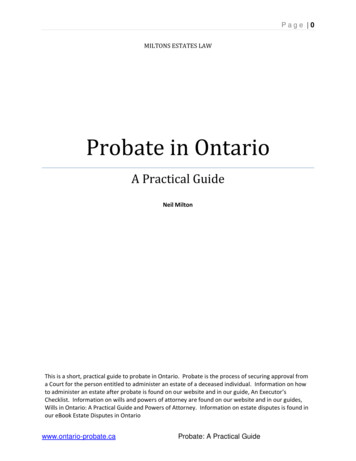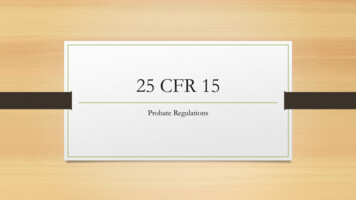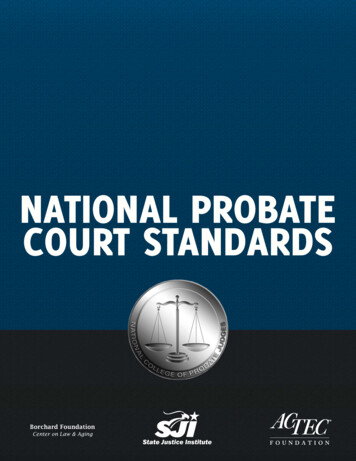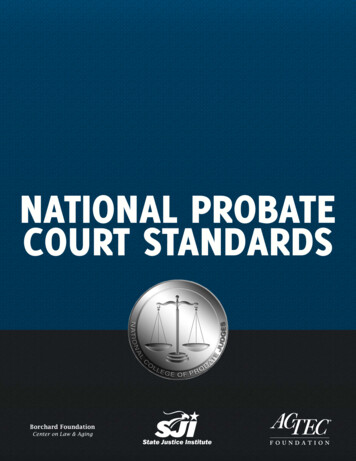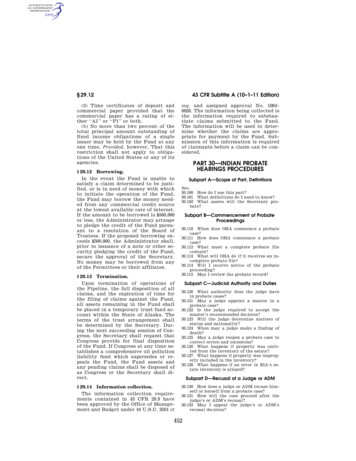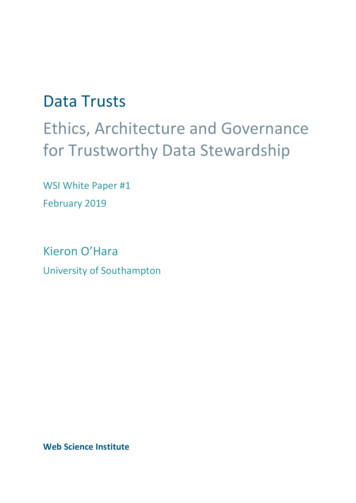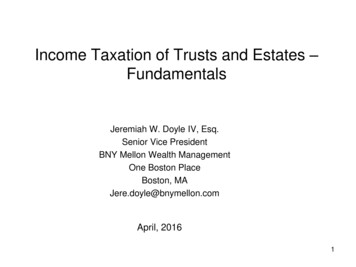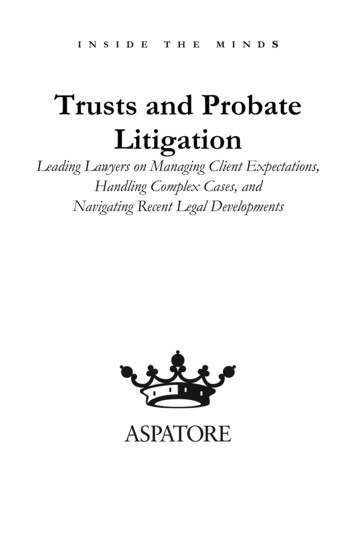
Transcription
I N S I D ET H EM I N D STrusts and ProbateLitigationLeading Lawyers on Managing Client Expectations,Handling Complex Cases, andNavigating Recent Legal Developments
2010 Thomson Reuters/AspatoreAll rights reserved. Printed in the United States of America.No part of this publication may be reproduced or distributed in any form or by any means, or stored ina database or retrieval system, except as permitted under Sections 107 or 108 of the U.S. Copyright Act,without prior written permission of the publisher. This book is printed on acid free paper.Material in this book is for educational purposes only. This book is sold with the understanding thatneither any of the authors nor the publisher is engaged in rendering legal, accounting, investment, or anyother professional service. Neither the publisher nor the authors assume any liability for any errors oromissions or for how this book or its contents are used or interpreted or for any consequences resultingdirectly or indirectly from the use of this book. For legal advice or any other, please consult yourpersonal lawyer or the appropriate professional.The views expressed by the individuals in this book (or the individuals on the cover) do not necessarilyreflect the views shared by the companies they are employed by (or the companies mentioned in thisbook). The employment status and affiliations of authors with the companies referenced are subject tochange.Aspatore books may be purchased for educational, business, or sales promotional use. For information,please email West.customer.service@thomson.com.For corrections, updates, comments or any other inquiries please emailTLR.AspatoreEditorial@thomson.com.First Printing, 201010 9 8 7 6 5 4 3 2 1If you are interested in purchasing the book this chapter was originally included in,please visit www.west.thomson.com.
Proactive Measures andKey Concerns for theTrust and Probate AttorneyRay J. Koenig IIIMemberClark Hill PLC
Inside the Minds – Published by Aspatore BooksThe Reasons for the Rise in Trust and Probate Litigation: Demographicsand Increasing ComplexityFor a variety of reasons, it seems that the “baby boomer” generation is themost litigious generation the world has known. The baby boomers’ parents—the so-called “greatest generation”—are also the wealthiest generation todate; they have more money than anybody ever had in the past. Now thoseparents are becoming disabled or dying and their children—the babyboomers—are fighting over their estates. Consequently, we have a situationwhere the most litigious generation is fighting over the funds from thewealthiest generation. This combination has led to a dramatic growth inprobate and trust litigation over the years—a trend which is only going tocontinue. The first set of boomers just turned sixty-five and the boomers’parents are well into their eighties. The boomers’ parents will begin dying inlarge numbers, which will only add to more litigation.Another cause for greater litigation is that estate planning techniques havebecome a lot more sophisticated over the years—but sometimes people donot know what they are doing when they are setting up or administeringthese complex structures. In fact, unless you are a bank or a largeinstitution, it can be difficult to serve as trustee or executor of one of thesenew trusts that contain sophisticated terms and vehicles. Due to lack ofknowledge, people are making mistakes, which lead to more errors andmore breach of fiduciary duty actions. Essentially, the more complicatedthings are, the more litigation there is.Causes of Actions in Estate and Trust ContestsThere are three primary causes of action in will and trust contests: lack ofmental capacity, undue influence, and tortious interference with anexpectancy. The facts of the case will determine whether one or all threecauses of action ought to be plead. Below is a brief outline of the elementsnecessary to plead each cause of action.Lack of Mental CapacityThe threshold for sufficient mental capacity to execute a will or testamentarytrust is quite low. The contestant must establish that the testator/settlor
Proactive Measures and Key Concerns for the Trust and Probate Attorneylacked the mental capacity to (1) know the nature and extent of his property;(2) know the natural objects of his bounty; and (3) have the ability to make adisposition of his property in accordance with some plan formed in his mind.In order to contest the execution of an inter vivos trust based on lack of mentalcapacity, the contestant must establish that the settlor lacked the capacitycontract. In other words, you need to have a higher level of capacity toexecute an inter vivos trust than a will or testamentary trust.Undue InfluenceUndue influence is present where the testator or settlor is prevented fromdisposing of his property in a manner he or she chooses. Instead, his or herfree will is so overcome that the disposition of his or her property reflectsthe wishes of the wrongdoer rather than the testator/settlor. Undueinfluence is rebuttably presumed if the contestant can establish thefollowing: (1) a fiduciary relationship existed between the testator/settlorand the person who benefits under the will/trust; (2) the primarybeneficiaries were in a position to dominate and control the dependenttestator/settlor; (3) the testator/settlor reposed trust and confidence inthese beneficiaries; and (4) the beneficiaries were instrumental in theprocurement or preparation of the will or trust. This presumption isrebuttable, however.Tortious Interference with an ExpectancyTo state a cause of action for tortious interference with an expectancy theplaintiff must allege: (1) the existence of an expectancy; (2) the defendant’sintentional interference with this expectancy; (3) the interference involvingconduct tortious in itself, such as fraud, duress, or undue influence; (4)reasonable certainly that the devise to the plaintiff would have beenreceived but for the defendant’s interference; and (5) damages. In Illinois, ifthe contestant could receive adequate relief through a will contest and hewas aware of his claim prior to the expiration of the limitations period, hemust seek redress through a will contest. Inter vivos transfers, however,cannot be recovered through a will contest. Thus, if the contestant believessomeone tortiously interfered with his expectancy to receive certain assets,such as insurance policies or a 401k, he may file a tortious interferenceaction against that alleged tortfeasor.
Inside the Minds – Published by Aspatore BooksBreaches of Fiduciary Duty by Executors and TrusteesA fiduciary is “a person who has a legal duty, created by his undertaking, toact for the benefit of another in matters connected with his undertaking.”Stephen H. Gifis, Black’s Law Dictionary (5th ed., 2003). A fiduciaryrelationship may exist as a matter of law or as a matter of fact. Examples offiduciary relationships that exist as a matter of law are: a trustee of a trust,an executor of a will, and an agent under power of attorney. Courts havefound a fiduciary relationship to exist in fact where, for example, anindividual took care of an elderly person’s health care and finances eventhough power of attorney documents were never executed. A fiduciary’sduties include inter alia: using reasonable care, skill, and caution, servingloyally and impartially, and not delegating his or her responsibilities.In regard to trusts, a trustee has fiduciary obligations to the trustbeneficiaries. A trustee may be sued for breach of fiduciary duty for, interalia, failing to invest trust assets prudently, not looking out for the bestinterests of all the beneficiaries, taking money from the trust, or failing toaccount to trust beneficiaries.In regard to wills, an executor has fiduciary obligations to the beneficiariesof the estate. The fiduciary may be sued for breach of fiduciary duty for,inter alia, failing to collect all estate assets, self-dealing (i.e., selling the estateowned home to himself for below fair market value); or failing toadminister the estate according to the terms of the will.The Impact of the Current Economic Landscape on Trust and EstateLitigationThe economy has not had a negative impact on my practice. My businesshas actually increased, but that could have more to do with the trajectory ofmy career than with the actual economy. I am a relatively young partner,and my business is expected to grow. However, I have noticed that therehave been fewer cases involving huge sums of money in the past year,largely because many of the big estates are not as big as they used to be dueto the real estate crash and market instability. Likewise, there tends to beless willingness to litigate what I would consider to be mid-sized estatesbecause of the cost-benefit analysis. Many of the cases that would have
Proactive Measures and Key Concerns for the Trust and Probate Attorneybeen brought a few years ago are not being brought now, simply becausethe litigants do not have the money to fund litigation and because thepotential payoff is not as great.One area of estate litigation that has increased dramatically is the number ofbreach of fiduciary duty cases brought against banks who serve as trustees.Trust beneficiaries want someone to blame for the downturn in theeconomy and the reduction in their interest income or the total value oftheir trust. Since they cannot sue the chairman of the Federal Reserve orCongress, they are suing the bank that served as trustee of the family’s trust.I defend banks in these types of cases. These cases are particularly stickybecause the issue is whether the bank acted in accordance with the prudentinvestor standard when investing trust assets during the recent real estateand stock market crash. Under these circumstances, it is difficult todetermine whether a corporate fiduciary was acting imprudently. Was itreally imprudent for the corporate trustee to invest trust assets in the stockmarket? Can the corporate trustee be liable to the beneficiaries for failing tocash out before the crash?Jurisdictional ConsiderationsProbate and trust litigation are practically always done at the state level. Allof my cases, for example, are in Illinois. For this reason, you must learn thelaws and customs that govern the state and county you are practicing in.For example, in Illinois, we have what is called a substitution of judges byright, which some states do not. Essentially, each party is allowed to suggesta judge’s substitution. Therefore, if you are not familiar with the judge inyour case you have to research their previous rulings and talk to otherpeople about the judge, and then discuss with your client if you want certainmatters brought in that courtroom.While there are state statutes that govern where I can file suit (i.e., a willcontest must be brought in the county where the decedent died), when Ihave the choice I prefer trying cases in Cook County. Of course, that is notto say that the judges in other counties are bad. In fact, the trust is far fromit. However, they do not see the volume and breadth of cases the judges inCook County see. In the smaller counties, where judges handle more thanjust probate, attorneys generally have to educate the judge more so than we
Inside the Minds – Published by Aspatore Booksdo in Cook County because we have judges that deal exclusively withprobate.While estate and trust litigation is typically handled on the state level, it isimportant to stay abreast of trends in other states. I have partners acrossthe country, and we discuss issues we are seeing and how courts areresolving them. Communicating with attorneys outside Illinois allows me tolearn new strategies and arguments that may be appropriate for my caseshere in Illinois.Components of Trust and Probate Litigation StrategyClient’s Goals and Key MotivationsThe first motivation in most trust and probate litigation is money, and thesecond is probably a person’s ego or desire to be vindicated on “principle.”I have found that whenever someone says that he or she is engaging inlitigation to defend a principle, it is usually because of his or her ego. Thethird motivation is some combination of affection, emotion, and familyhistory. For example, clients often tell me that there is no way their mothercould have wanted one of their siblings to receive more of an inheritancebecause she always told the client that he or she was her favorite. Theperson usually initiates litigation to defend the belief that he or she was thefavorite and some wrongdoing had to have occurred for his or her motherto leave so much to the other siblings rather than to him or her.At the outset of any trust and probate litigation, I always try to identify thegoals of my client—i.e., what is it they want, and what is it that they expectto achieve. From that point, I figure out what is legally possible. I do thisbecause what the client wants and what you can actually legally achieve areoften very different things. As stated earlier, many of these cases are drivenby emotions: some clients just want to know that their mother loved all ofher children equally, but their mother is dead. Other times the client reallywants their sibling to apologize, and that is just not going to happen,whether we settle or win at trial.I always advise my clients to think seriously about whether or not they wantto bring litigation; it is emotionally and financially draining. If the client will
Proactive Measures and Key Concerns for the Trust and Probate Attorneyend up spending 200,000 on litigation, and the most they can get out of itis 300,000, they need to decide if they should go through with it. Some willchoose to proceed because they are emotionally invested in vindicatingwhat they believe to be the decedent’s true intent. Others will be morepragmatic and may recognize it is not worth the fight.Therefore, when I build a litigation strategy, it is important to identify theclient’s goals and what is legally possible. Then I talk to the client aboutthose issues, and try to get them back down to earth if necessary.Educating the Client and Setting ExpectationsClient education is extremely important in these cases. If a client’sexpectations are improperly managed, you will have a very unhappy client.In fact, I will decline cases where the client has unreasonable expectationsabout what he or she can or cannot do in a will or trust contest.When working with a client on a probate or trust matter, it is important tolisten and never condescend. The counseling process is part therapy andpart education. If you seriously consider the client’s feelings or emotions,you will often be able to recognize what is really motivating them inbringing or defending the litigation. You have to spend some non-billabletime on the phone with the client discussing their motivation. They havegenerally been thinking about these issues for a long time, and they want toshare their feelings with someone who cares—their attorney.I tend to not have to educate bank clients as much because these clients areprofessionals who do this for a living. They frequently know almost asmuch about the law as I do. Again, however, individual clients typicallyhave no background in estates and trusts and require continuous educationon the law and the process of estate/trust litigation.I try to make a client wait a couple of days before deciding to move forwardwith non-mandatory litigation. It is crucial for the long term. It is notnecessarily the best business decision to rope a client into doing somethingthey do not necessarily want to do, because, in the end, they are not goingto want to pay for it. Litigation is a huge emotional and financialinvestment; the client has to be committed. Therefore, I try to make them
Inside the Minds – Published by Aspatore Bookswait a couple days before they make the decision to go forward and thatvery rarely backfires. In fact, it usually allows the client to come up withmore questions, and only then will they be ready to decide whether they aregoing to actually commit to the litigation.Stay Organized and Simplify Your CaseIn order to succeed in these cases, you need to know your facts and the lawvery well. Keep yourself and your facts organized. The discovery process willlead to an overload of information, so it is important to be organized fromday one. Create timelines and summaries and always have a running list ofquestions that you will go back to check and recheck. This will help younarrow down your case and stay focused on what you need to prove. In everycase, you must prove to a judge or a jury that your facts demonstrate thatonly one legal outcome is appropriate. In order to do this, you must pinpointyour goal and simplify your case. Judges and juries respond to simplicity.You want to give the judge and jury an explanation they can easily agreewith. If you take a complex issue and make it easy for them to understand,it is easier for them to agree with you. This strategy is sometimes easier toachieve with a jury than with a judge. The judge may have used suchstrategies themselves and may reject them. Regardless, it is always a goodidea to simplify your case as much as possible.Achieve Early VictoriesIt is important to consider what you can do to bring about an earlysettlement that is favorable to your client—and one way to do that is to tryto quickly obtain early moral and legal victories. I will often try tosomewhat demoralize the other side by defeating any unfounded claims asearly as possible and poking holes in their facts. Basically, I try to get rid ofthe big dramatic elements in the other party’s case while attempting to scorean early legal victory. Even a small victory develops momentum, which willmake the other side reconsider the strength of their case. Each party comesinto litigation thinking that they know the truth and they are going to win.The mentality is: how could a judge or jury ever decide otherwise? However, youhave to show the other side as well as the judge or jury that the case couldindeed be decided otherwise. You must attempt to achieve as many of those
Proactive Measures and Key Concerns for the Trust and Probate Attorneyvictories as early as possible. All of these early efforts will allow you (andthe judge) to properly assess the strengths of the case. By achieving earlyvictories in court and persuading the other side of the strength of your case,you are educating the judge and making them familiar with your side of thestory—this helps in the long run.I will always try to bring an action in a way that leverages the strengths ofmy client’s case. My goal in every case is not necessarily to win at trial. Iwant to win, but I do not defend litigation based solely on how it wouldplay out at trial. Early victories typically allow me to reach a settlement withthe other side, making trial unnecessary.Educate the JudgeIt is important to educate the judge on the simple theory behind your caseearly as possible. For example, in some instances it may be important to filea certain motion, not because you absolutely believe you will win themotion, but because it is an opportunity to educate the judge on the facts ortheory of the case. I have also filed certain motions in order to educate thejudge on the unsavory tactics of my opposing counsel, so that the judge ison notice of whom she or he is dealing with. Educating the judge on thefacts benefits my client in the long run.Preparing for Litigation: Building your Team:Legal AssistantsSome of the best litigators have amazing assistants. In fact, in my opinion,you cannot become a successful attorney, especially in litigation, without anassistant who understands the basics of the law, gets along well with clientsand opposing counsel, and can handle many of the procedural aspects ofthese cases, thus alleviating the responsibility and worry from you.Associates/PartnersAssociates and paralegals are crucial in a successful trust and estate litigationpractice. The number of such people on a case varies with the complexityof the case. I will handle a smaller case myself, but there are some cases
Inside the Minds – Published by Aspatore Bookswhere I have four partners and three or four associates working with me,because the case is complex and involves a lot of work.I benefit from working in a larger firm where I can have other partners lookat the issues in my case to get an outlook from a fresh set of eyes. Becauseprobate and trust litigation may touch on many areas of the law, I will alsobring in a partner who specializes in tax or real estate or whatever the caserequires in order to provide my client the best possible team to litigate hisor her case.Advice and Counsel from Attorneys outside the CaseWhen you are working on a case with people in your firm, you sometimestend to suffer from group think. For example, associates may adopt myinterpretation as their own, rather than thinking about an issue forthemselves. In an effort to avoid group think, I have been known to retainoutside attorneys to analyze a specific subject or specific issues. Of course,it will cost the client a little more, but not too much more, because theywould have paid me for that time anyway. Most importantly, I will be ableto get a different perspective from someone who is not immersed in thecase, which can bring a favorable outcome to the client.In addition, the probate attorneys in Chicago are a pretty collegial bunchwho are often willing to give a few minutes of their time to analyze an issueor recommend an expert referral.ExpertsOutside experts are extremely important in trust and estate litigation. Sincethe testator/settlor’s mental capacity is often at issue, it is generallynecessary to present his or her physician or another medical expert who candiscuss his or her mental capacity and medical condition. Physicians andnurses are frequently retained for this reason.In addition, forensic accountants are frequently used as experts. Forexample, if a trust owns shares of a family business, an accountant may bebrought in to analyze the value of the business. Similarly, if a trustee suedfor breach of fiduciary duty, compiling a complete trust accounting and
Proactive Measures and Key Concerns for the Trust and Probate Attorneyanalyzing the trustee’s actions with respect to the trust’s assets will alsorequire an expert accountant.I frequently rely on word of mouth for finding the appropriate expert for acase. Over time, I have developed good relationships with some doctorsand accountants, who I will call on since I know and respect their level ofprofessionalism. I tend to avoid hiring experts who have referred mebusiness because I do not want any bias to affect my client’s case.Complex Trust and Probate CasesSuccessive DocumentsWhat I consider a complex trust or probate case is a case that involves a lotof successive documents—i.e., the client executed a new trust every year forfifteen years, and they were either unduly influenced or lacked capacity toexecute those documents over the last six years. Therefore, you have tocontest six successive documents. That usually entails six successive trials tocontest the validity of each document. That gets very expensive, whichusually encourages settlement.Tax IssuesIf a case involves trust construction, undue influence, or lack of capacitymatter, and taxes are at issue, the case frequently becomes infinitely morecomplex. Our tax code has changed a great deal over the years, and whenestate documents have been executed in different years, the challengeinvolves trying to figure out why the client did what they did, and how the taxlaw has changed since that time. Basically, you are trying to argue to the judgethat the client did certain things for a particular reason, and that makes thecase a bit more complex—i.e., if when the client executed their estatedocuments, they were trying to take advantage of a law under the tax schemethat existed at that time, which may be very different than the present laws.Multiple Parties and Conflicts of InterestMultiple invested parties with conflicting interests also make for a complextrust or probate case. I have had cases where there were fifteen attorneys, all
Inside the Minds – Published by Aspatore Booksrepresenting different clients and with different agendas. In such a case, I maybe aligned with half the parties and against half the parties on certain motions.Resolving such a case takes incredible organizational skills and a good team.The Fine Line in Breach of Fiduciary Duty CasesAnother type of complex case is if a beneficiary files a breach of fiduciaryaction and the facts are unclear as to whether there was in fact a breach ofduty. Many of these cases involve investment decisions that were made overthe last four or five years. Issues in these types of cases are whether aparticular bank should or should not have taken a certain action, andwhether its action or inaction constitutes a breach of fiduciary duty. Thesecases are becoming more complex, because in the past when the marketwas always going up and you lost money, it was easier to prove a breach,but in this economy, a loss of 10 to 15 percent may or may not necessarilybe a breach. Therefore, you are dealing with a lot more financial andeconomic data than in most cases, which often requires the use of an expertto sift through it and draw conclusions.Recent Trends and Changes in the LawA Tortious Interference with an Expectancy Action May Be Filed After the Six MonthPeriod for Filing a Will Contest Has PastThe Illinois Supreme Court held in In Re Estate of Ellis that a tortiousinterference with expectancy action, in certain circumstances, may be filed afterthe six month statute of limitations to file a will contest has expired. In re Estateof Ellis, 236 Ill. 2d. 45, 923 N.E.2d 237 (2009). In Ellis, the decedent namedShriners Hospitals for Children as beneficiary under her 1964 will, provided shehad no descendants. In 1999, the decedent wrote a new will naming her pastoras the sole beneficiary of the estate. The decedent died in 2003 with nodescendants and her 1999 will was admitted to probate. Shriners did not learnof their interest under the 1964 will until 2006, well after Illinois’ six monthclaim period to file a will contest had run. Shriners brought suit against theestate alleging, among other things, tortious interference with an expectancy.Shriners alleged that the reverend knowingly interfered with Shriners’expectancy under the 1964 will by abusing his position of trust by unduly
Proactive Measures and Key Concerns for the Trust and Probate Attorneyinfluencing the decedent to execute a new will. Shriners alleged that but forthe reverend’s interference, Shriners would have received the estate. Thelower courts dismissed the claim as untimely because it was not filed withinthe six month limitation period for filing a will contest that they applied totortious claims. The lower court reasoned that the legislature could not haveintended to bar a will contest after six months but permit identicalallegations to proceed in through a tort action. This had been the generalunderstanding for years.The Supreme Court reversed, finding that a tortious interference claim isnot limited by the six month limitation period in the Probate Act becausethe six month limitation period explicitly states that it only applies to willcontests. Moreover, the purpose of a will contest, even if the allegations arethe same as a tortious interference action, is entirely different. A successfulwill contest will set aside a decedent’s will, whereas a tortious interferenceaction is directed toward the individual tortfeasor and if successful willresult in a judgment against the individual defendant. The Illinois SupremeCourt noted that had Shriners known about their interest early enough tofile within the six month limitation period they would not have waited untilafter the period ran to file their tort action.In sum, the Illinois Supreme Court held that while a tortious interferenceaction is not governed by the six month limitation period, if the contestantknew about the tort and could have brought the action during the sixmonth limitation period and received adequate relief through a will contest,the contestant is required to file a will contest instead of a tortiousinterference action. If, however, a will contest will not provide adequaterelief, then the contestant can proceed with his or her tort action. TheIllinois Supreme Court allowed Shriners’ claim to proceed because Shrinersdid not learn about their expectancy until well after the limitation period,and a will contest would not have provided it adequate relief becausenumerous assets were transferred to the reverend outside of probate.This case is important because it expands the opportunity to litigate estates.Prior to Ellis, most practitioners and trial court judges understood the lawto be that any action to contest a will or trust, or to bring a tortiousinterference action, had to be filed within the six month limitation period.While the Illinois Supreme Court attempted to narrow their decision to the
Inside the Minds – Published by Aspatore Booksfacts of Ellis, the case has nevertheless opened the door for parties tolitigate estates well after they have been administered based on a claim oftortious interference, provided the contestant did not have notice within thesix month limitation period. As a result, attorneys who administer estatesmay want to consider giving notice to any individual or entity known tohave had an interest in a prior will in order to foreclose on an individual orentity bringing an action well past the six month limitation period. Ofcourse, providing them that notice may invite litigation as well.This case obviously benefits litigators in that it expands our opportunity tobring a cause of action. However, litigators nevertheless need
Causes of Actions in Estate and Trust Contests There are three primary causes of action in will and trust contests: lack of mental capacity, undue influence, and tortious interference with an expectancy. The facts of the case will determine whether one or all three causes of action ought to be plead. Below is a brief outline of the elements
